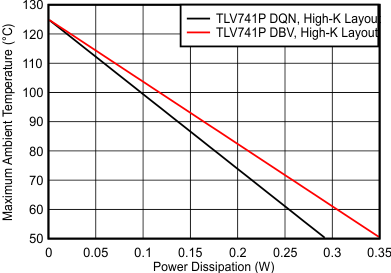SBVS309A July 2017 – September 2018 TLV741P
PRODUCTION DATA.
- 1 Features
- 2 Applications
- 3 Description
- 4 Revision History
- 5 Pin Configuration and Functions
- 6 Specifications
- 7 Detailed Description
- 8 Application and Implementation
- 9 Power Supply Recommendations
- 10Layout
- 11Device and Documentation Support
- 12Mechanical, Packaging, and Orderable Information
Package Options
Mechanical Data (Package|Pins)
Thermal pad, mechanical data (Package|Pins)
- DQN|4
Orderable Information
10.3 Power Dissipation
The ability to remove heat from the die is different for each package type, presenting different considerations in the printed-circuit-board (PCB) layout. The PCB area around the device that is free of other components moves the heat from the device to the ambient air. Performance data for JEDEC low- and high-K boards are given in Thermal Information. Using heavier copper increases the effectiveness in removing heat from the device. The addition of plated through-holes to heat-dissipating layers also improves the heat sink effectiveness.
Power dissipation depends on input voltage and load conditions. Power dissipation (PD) can be approximated by the product of the output current times the voltage drop across the output pass element (VIN to VOUT), as shown in Equation 3:

Figure 29 shows the maximum ambient temperature versus the power dissipation of the TLV741P. This figure assumes the device is soldered on a JEDEC standard, high-K layout with no airflow over the board. Actual board thermal impedances vary widely. If the application requires high power dissipation, having a thorough understanding of the board temperature and thermal impedances is helpful to make sure the TLV741P does not operate above a junction temperature of 125°C.
 Figure 29. Maximum Ambient Temperature vs Device Power Dissipation
Figure 29. Maximum Ambient Temperature vs Device Power Dissipation Estimate junction temperature by using the ΨJT and ΨJB thermal metrics, shown inThermal Information. These metrics are a more accurate representation of the heat transfer characteristics of the die and the package than RθJA. The junction temperature can be estimated with Equation 4:

where
- PD is the power dissipation shown by Equation 3,
- TT is the temperature at the center-top of the device package,
- TB is the PCB temperature measured 1 mm away from the device package on the PCB surface.
NOTE
Both TT and TB can be measured on actual application boards using a thermogun (an infrared thermometer).
For more information about measuring TT and TB, see Using New Thermal Metrics , available for download at www.ti.com.